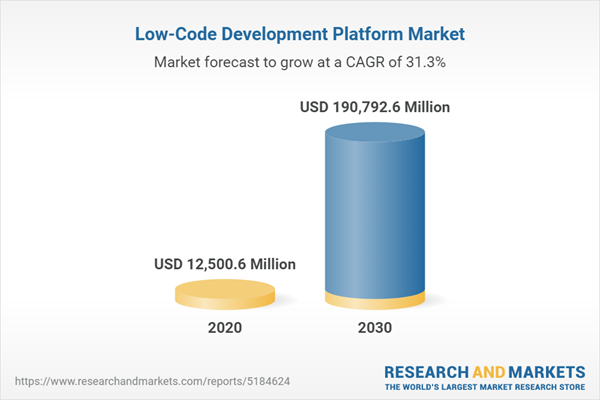
Is Low-Code/No-Code the Future? 5 Most Important Trends
Will developers always be needed? Are low-code and no-code platforms going to replace traditional programming? Is low-code/no-code really the future? In this article, we will reflect on why the popularity of these tools is growing and what the most important trends are.
Urgent need of digital transformation
The experiences of recent years, especially those related to the pandemic, show that the need for new technological solutions is growing among organizations in various industries. In other words, digital transformation has become crucial. And its main objective is to enable building apps or websites to non-technical people in a short period of time.
Many would ask: why is it so expensive to incorporate modern, digital solutions? Is there any more accessible alternative to custom software development?
Here’s the answer: no-code and low-code development.
This approach to application development allows people with no or little technical expertise (so-called citizen developers) to create customized solutions using dedicated platforms.
Low-code and no-code tools seem to be the right choice for small and medium organizations outside IT. It applies especially to users whose aim is to meet their business goals fast, efficiently, and at a low cost using modern technology.
[Read also: What’s the Future of Digital Transformation and Its Trends? An Expert’s Point of View ; The Role of Low-Code in Digital Transformation]

According to Gartner, in 2021 41% of non-IT employees were involved in customizing and building apps. In the same report, it is predicted that by the end of 2025 half of all new low-code clients will come from outside IT. This means that the demand for digital solutions is constantly growing and, consequently, it is getting easier to access them thanks to no-code and low-code development platforms.
“While low-code application development is not new, a confluence of digital disruptions, hyperautomation and the rise of composable business has led to an influx of tools and rising demand,” Fabrizio Biscotti, research vice president at Gartner.
So we know that there is a great demand in the market for this type of tool. But the question is: are no-code/low-code tools as perfect as they seem to be? What’s the catch?
What is no-code and low-code development
Low-code and no-code platforms is a software development approach that enables business users with no-coding knowledge to build apps using drag-and-drop options instead of writing code. Thanks to this solution, an application development process is less expensive and time-consuming.
However, low-code and no-code platforms put some limits when it comes to the development of more advanced features.
As we have already mentioned in our introductory post about low-code and no-code development, the customizations of applications may be unachievable in some scenarios. Even though low-code enables professional developers to modify the code to some extent, changes are more difficult and complex than in the traditional software development.
When and why is a low-code or no-code used? In small businesses, mostly to build simple and non-risky applications related to visual analytics, workflow automations as well as to develop web and mobile sites.
The graph below shows the most popular reasons for using such tools.

It is worth emphasizing that for large organizations, which need advanced and custom software applications, low-code and no-code may not be sufficient due to its limits.
What is the impact of this technology on the IT industry? Will low-code/no-code replace programmers? What is the future of software development? These questions cannot be answered unequivocally, but it is worth looking into the current trends that shape the tech industry and get a bigger picture.
Read also: Low-Code Gartner Forecasts for 2023
5 most important no-code/low-code trends that are changing IT industry
How is low-code/no-code changing the industry? What is its future? To answer this question, let’s take a look at current trends related to low-code and no-code development and its influence on the software development industry.
Read also: How to Choose a Software Development Company in 2022 [CHECKLIST]
1. Low entry threshold for application development
Low-code and no-code platforms are changing app and software development by making a very low entry barrier for people who don’t have a programming background. An intuitive interface with drag-and-drop features helps users create custom solutions for their business needs.

Apparently, it seems that easy access to app development also positively affects job satisfaction and tech skills.
As Microsoft study shows, 82% of low-code/no-code users agree that the technology helps give software users the chance to advance their technical expertise and knowledge of software development.
Additionally, it has been demonstrated that the usage of no-code or low-code platforms or apps has had an 83% good influence on users’ job satisfaction and workload, as well as an 80% positive impact on users’ morale.
2. Democratization of Programming
Nowadays, apps are becoming indispensable not only at work and in business, but also in everyday life – at the bank, while traveling, shopping or at the gym. These more complex and advanced applications are developed by professional programmers with a large amount of capital.
However, simpler applications, such as those for workflow management or data analysis, can be created by non-developers thanks to an improved user experience.
This new approach is called democratization of technology.
IT democratization makes organizations perform better because more people outside IT have access to technical knowledge.
According to Accenture, 87% of utility executives believe technology democratization is becoming critical in their ability to ignite innovation across their organization.

Thanks to low-code and no-code platforms, more and more people without programming backgrounds are closer to technology and don’t need to spend years learning how to code to create a customized application.
Instead, as data from Low-Code Application Development Trends survey shows, 70% of their users learned low-code in 1 month or less and 73% of users were developing apps within 3 months or less.
3. Cost and speed of development
The main reason many business users choose low-code tools is simple: time and money.
Nowadays, platforms for low-code development are part of a crucial strategy to help with the rapid application development and quick deployment. Software development with no-code and low-code tools takes much less time compared to traditional development.
What is more, low-code platforms accelerate business processes by making it easier to exchange information within one company, as well as standardize a enterprise software development process across business and IT teams.
[Read also: How to estimate the cost of software development]
4. Hyperautomation
Low-code is widely used in the automation of business processes.
In order to increase productivity, optimize costs and improve workflow, enterprises use technologies such as robotic process automation (RPA), artificial intelligence (AI) and low-code application platforms (LCAP). The latter allows employees to create personalized applications that facilitate, collect, manage and exchange data across organizations.
This modern, business-driven approach to rapidly automated processes is called hyperautomation. Incorporating it into your business enables scalability, remote operation and prevents disruption to your business model.
One of the top factors driving the adoption of low-code through 2022 will be the demands of business-driven hyperautomation.
It’s worth adding that, according to Gartner‘s insights, hyperautomation is one of the 12 top strategic technology trends for 2022.

Source: Gartner
5. Software as a Service
Nowadays, low-code software development is becoming an important SaaS trend. Thanks to its low entry barrier, anyone who doesn’t have coding skills is able to enter the SaaS market with products built with a low-code platform.
On the other hand, the main SaaS companies provide capabilities that include low-code development tools for their users.
[Read also: Your Guide to Digital Finance Transformation]
Growing importance of low-code development market
To answer the question if low-code/no-code is the future, we will look at real numbers.
The low-code market was valued at almost 12 500 million U.S. dollars in 2020, and is forecast to reach approximately 191 million U.S. dollars in 2030. The market is projected to grow with a CAGR of 31.3 percent over this period, according to Low-Code Development Platform Market Research Report.

Source: Research and markets
More and more companies are using low-code technology outside of IT departments. It is predicted that by 2025, low-code or no-code technologies will be used in 70% of new applications developed by organizations.
The remote working regulations, movement restrictions, and general lockdowns that were implemented during the COVID-19 pandemic resulted in the rise of the popularity of low-code.
Will no-code and low-code platforms replace traditional software development?
Creating a solution that would replace expensive programmers has been a golden grail of IT for a long time. Low-code is one such attempt. But is it efficient?
Arkadiusz Drysch, CTO at Stratoflows, shares his thoughts on this subject:
“I believe that we are at a stage where we have disenchanted the myth that someone who does not program can create any application. The naive approach is that you can make such a solution that anyone can operate. There will always be nuances. If we want to reduce the complexity of an application, we have to expect that it will be at the expense of its quality”.
So will no-code replace code? To answer this question, we have to analyze to what extent no-code/low-code can be an advanced tool.
Over time, as the application becomes more advanced, there is a demand for an appropriate level of technical background. This means that time is needed to educate and familiarize oneself with the no-code software. As a result, a demand for low-code specialists emerges.
To illustrate an application complexification process, the SQL language can be recalled as an example. It was intended to be an accessible solution for everyone to facilitate database management. However, over time, it became a separate programming language. A regular user is unable to comprehend or write complex SQL queries. They have to learn SQL in order to understand the structure of the database.
We predict that the same thing happens with low-code applications. The more complex the application, the more resources are needed to know how to operate it.

As Jasper Hans points out in his article: “low-code/no-code platform will be impossible to accomplish “Product Standardization” if it is positioned in data and internal systems. It will be impossible to rely only on low-code/no-code products if they are focused on tackling information non-circulation and inefficiency inside the organization. To overcome this challenge, you’ll need personnel development and customer participation.”
In conclusion, low-code will work well in the future for a variety of simple business apps, but not for advanced, custom apps. Traditional programming is then required.
Is low-code/no-code the future? Summary
Nowadays to create simple applications we use low-code and no-code development platforms. The trend is significant in the market. However, it is worth noting that most applications reach such a stage of development at some point that customization IT departments or outsourcing software development always will be needed. The future of low-code is promising for simple business applications, but it is important to remember that there will always be a need for a specialist who can create more complex systems.
Related Posts
- Enterprise Software: What It Is and 12 Best Application Examples
- How to Build an App Without Coding: 5 Must-Know Tips
- Online Shopping Recommendations – How to Introduce Them in Your Business?
- Amazon Product Recommendation System: How Does Amazon’s Algorithm Work?
- Movie Recommendation System: How It Works And How To Introduce It In Your Business
We are Stratoflow, a custom software development company. We firmly believe that software craftsmanship, collaboration and effective communication is key in delivering complex software projects. This allows us to build advanced high-performance Java applications capable of processing vast amounts of data in a short time. We also provide our clients with an option to outsource and hire Java developers to extend their teams with experienced professionals. As a result, the solutions designed for our customers contribute to their business development. We specialize in travel software, ecommerce software, and fintech software development. In addition, we are taking low-code to a new level with our Open-Source Low-Code Platform.